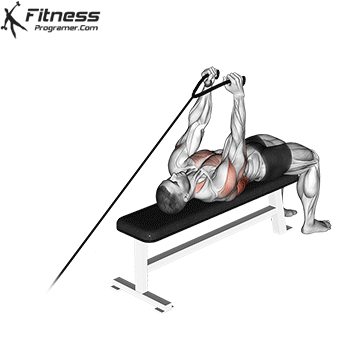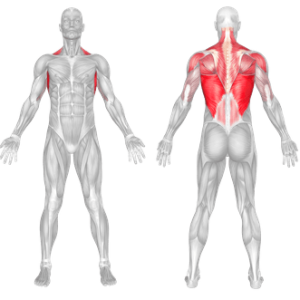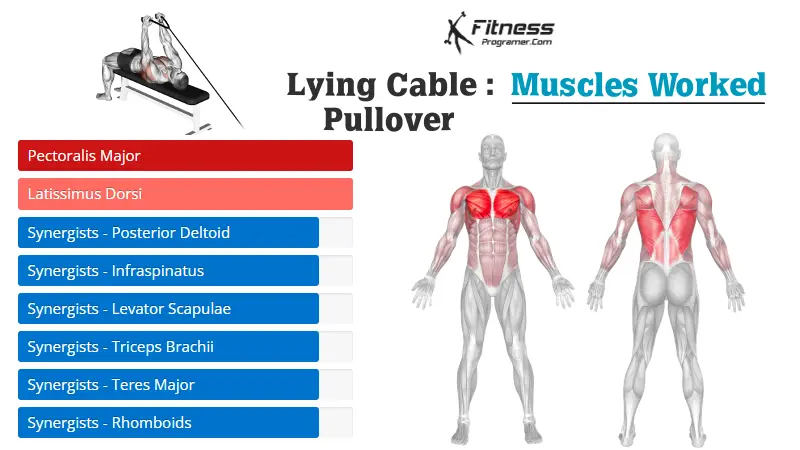Overview
The lying cable pullover is a compound exercise targeting the pectorals, latissimus dorsi, and surrounding muscles using a cable machine. Performed while lying on your back, it allows for controlled shoulder extension and scapular movement with minimal body momentum. This position makes it ideal for improving muscle activation, posture, and core stability in both strength and hypertrophy programs.
How to Perform the Lying Cable Pullover

Set up the cable machine: Attach a rope or straight bar to the pulley. Lie face up on a flat bench or the floor.
Grip the handle with straight arms: Hold the bar or rope overhead with a slight bend in your elbows. Keep feet flat on the bench or knees bent on the floor.
Pull the cable down with your lats and pecs: Bring the handle down in an arc toward your hips while keeping your arms extended.
Pause and contract at the bottom: Squeeze your lats and chest muscles, keeping your shoulders stable and down.
Return slowly to the start: Control the cable as it pulls your arms back overhead, maintaining tension on the muscles.
Tips for Proper Form
Maintain a slight bend in the elbows to protect the joints.
Engage your core to stabilize your spine during the movement.
Avoid using momentum; perform slow, controlled reps.
Keep shoulders depressed and scapulae stable.
Choose a weight that allows full range of motion without compensations.
Common Mistakes
Locking elbows fully, which can cause strain and reduce muscle activation.
Letting shoulders shrug upward during the exercise.
Swinging the arms or using momentum instead of muscle control.
Arching the lower back excessively while pulling.
Moving too quickly during the eccentric phase, losing muscle tension.
Benefits of the Lying Cable Pullover
Targets Both Pecs and Lats Effectively: This compound movement develops strength and size in major upper body muscles simultaneously.
Enhances Core Stability and Spinal Support: Lying position requires abdominal engagement, improving overall trunk control.
Reduces Lower Back Stress Compared to Standing Variations: The bench or floor support helps protect the lumbar spine during heavy pulls.
Improves Shoulder Mobility and Scapular Control: Controlled shoulder extension promotes better posture and joint health.
Maintains Continuous Tension for Muscle Growth: Cable resistance ensures muscles stay engaged through the full range of motion.
Versatile for Rehab, Hypertrophy, or Accessory Training: Suitable for various training goals by adjusting load, reps, and tempo.
Facilitates Better Mind-Muscle Connection: The stable position allows focused activation of targeted muscles.
How to Incorporate Into Your Routine
- For Beginners: Perform 2–3 sets of 12–15 reps with light weight to develop proper form and muscle awareness.
- For Hypertrophy: Use 3–4 sets of 8–12 reps at a controlled tempo, emphasizing the stretch and contraction of the lats and pecs.
- For Strength: This exercise is best as accessory work rather than a primary strength movement; perform 3–4 sets of 8–10 reps after heavy compound lifts.
- For Functional Training: Pair with core stability exercises or scapular control drills to improve posture and movement quality.
- For General Fitness: Add 2–3 sets of 12 reps at the end of back or chest workouts for balanced muscle development.
Lying Cable Pullover: Muscles Worked

Frequently Asked Questions
Does the lying cable pullover work the chest as well as the back?
Yes, it targets both the pectorals and lats effectively as a compound movement.
Can this exercise be done without a bench?
Yes, performing it on the floor is a good alternative if a bench is unavailable.
Should I use a rope or straight bar attachment?
Both are effective; the rope allows a slightly greater range of motion at the bottom.
Is this exercise safe for people with shoulder problems?
When done with proper form and moderate weight, it can support shoulder health and mobility.
How should I breathe during the movement?
Exhale as you pull the cable down, inhale while returning to the start position.

